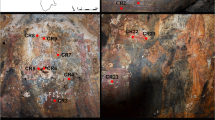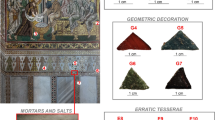Abstract
This work focuses on the archaeometric study of mortars and pigments coming from the “Mosaico della Sala dei Draghi e dei Delfini”, the oldest and most complex Hellenistic mosaic of the Magna Graecia, located in the Hellenistic baths of the archaeological site of Kaulonía (Southern Calabria, Italy). From this mosaic, mortar samples belonging to different stratigraphic sequences and coloured filling mortars were analyzed through polarized optical microscopy (OM), microanalysis scanning electron microscopy with energy-dispersive X-ray spectroscopy (SEM-EDS) and Raman spectroscopy.
To study the executive technique and the typology of pigments used in the mosaics of the Magna Graecia, it was considered another mosaic of Kaulonía: the “Mosaico della Casa del Drago”, the first polychrome mosaic discovered in the ancient city, which represents the figure of the dragon. From this last mosaic, one sample of painted surface lime was collected and compared with the coloured filling mortars of the Mosaico della Sala dei Draghi e dei Delfini.
In addition, a sample of Jurassic limestone with red mineralizations, from the north of the city of Stilo, was sampled to study the provenance of the pigments used.
To this day, research has not yet focused on the compositional study of the Hellenistic mosaics of Kaulonía. For this reason, this work wants to give, for the first time, information about the executive techniques of these mosaics and the composition of mortars and pigments, increasing the knowledge on the production technology of the mosaic in the Hellenistic period and, in particular, in the archaeological site of Kaulonía.













Similar content being viewed by others
References
Allen JRL, Fulford MG (2004) Early roman mosaic materials in southern Britain, with particular reference to silchester (calleva atrebatum): a regional geological perspective. Britannia 35:9–38
Bakolas A, Biscontin G, Moropoulou A, Zendri E (1995) Characterization of the lumps in the mortars of historic masonry. Thermochim Acta 269(270):809–816
Barba L, Blancas J, Manzanilla LR, Ortiz A, Barca D, Crisci GM, Miriello D, Pecci A (2009) Provenance of the limestone used in Teotihuacan (Mexico): a methodological approach. Archaeometry 51:525–545
Barca D, Miriello D, Pecci A, Barba L, Ortiz A, Manzanilla LR, Blancas J, Crisci GM (2013) Provenance of glass shards in archaeological lime plasters by LA-ICP-MS: implications for the ancient routes from the Gulf of Mexico to Teotihuacan in Central Mexico. J Archaeol Sci 40:3999–4008
Barra Bagnasco M, Casoli A, Chiari G, Compagnoni R, Davit P, Mirti P (2001) Mineralogical and chemical composition of transport amphorae excavated at Locri Epizephiri (southern Italy). J Cult Herit 2:229–239
Boggs S Jr (2010) Petrology of sedimentary rocks, 2nd edn. Cambridge University Press, Cambridge
Bonardi G, Messina A, Perrone V, Russo S, Zuppetta A (1984) L’Unità di Stilo nel settore meridionale dell’Arco Calabro-Peloritano. Boll Soc Geol Ital 103:279–309
Boschetti C, Corradi Bonamartini A, Fabbri B, Leonelli C, Macchiarola M, Ruffini A, Santoro S, Speranza M, Veronesi P (2007) Caratterizzazione archeometrica dei mosaici del ninfeo della Domus del Centenario, in Santoro S (ed) Pompei. Insula del Centenario (IX,8). Indagini diagnostiche geofisiche e analisi archeometriche. Antequem, Bologna, pp 259–308.
Boschetti C, Corradi A, Baraldi P (2008) Raman characterization of painted mortar in Republican Roman mosaics. J Raman Spectros 39:1085–1090
Carò F, Riccardi MP, Mazzilli Savini MT (2008) Characterization of plasters and mortars as a tool in archaeological studies: the case of Lardirago Castle in Pavia, Northern Italy. Archaeometry 50:85–100
CGC (1968) Carta Geologica della Calabria. Foglio 247, III N.O. Cassa per il Mezzogiorno, Napoli
Crisci GM, Franzini M, Lezzerini M, Mannoni T, Riccardi MP (2004) Ancient mortars and their binder. Period Mineral 73:259–268
Cuteri FA (2008) Nuovi documenti sull’area mineraria di Pazzano (RC). Studi Calabresi, II-III, 3–4, 2002–2003, pp 223–242
Cuteri FA, De Natale A, Iannelli MT, Gazineo F, Mantella G (in press) I mosaici ellenistici nel balineon dell’antica Kaulonia (Monasterace M.-Calabria). Dallo scavo al restauro. Modalità di documentazione e schedatura dei materiali, delle decorazioni e delle tecniche esecutive. In: Conservation and Presentation of Mosaics: At What Cost?, Proceedings of the 12th Conference of the International Committee for the Conservation of Mosaics, October 2014, Sardinia. Getty Publications, California (USA), pp 27–31
Damiani D, Gliozzo E, Memmi I, Turbanti I, Spangenberg JE (2003) Pigments and plasters discovered in the house of Diana (Cosa, Grosseto, Italy): an integrated study between art history, archaeology and scientific analyses. Archaeometry 45:341–354
Dekayir A, Amouric M, Olives J, Parron C, Nadiri A, Chergui A, El Hajraoui MA (2004) Structure et caractérisation des matériaux utilisés dans la construction d’une mosaïque romaine de la cité de Volubilis (Maroc). Comptes Rendus Geoscience 336:1061–1070
De Luca R, Cau Ontiveros MA, Miriello D, Pecci A, Le Pera E, Bloise A, Crisci GM (2013) Archaeometric study of mortars and plasters from the Roman City of Pollentia (Mallorca-Balearic Islands). Period Mineral 82(3):353–379
De Francesco AM, Iannelli MT, Barrese E, Andaloro E, Imperitura VG, Bocci M (2009) Provenance and technology of bricks from the Greek colony of Kaulon (Calabria, Italy). Period Mineral 78:37–49
Dunbabin KMD (1979) Technique and materials of Hellenistic mosaics. Am J Archaeol 83(3):265–267
Franzini M, Leoni L, Lezzerini M, Sartori F (2000) The mortar of the “leaning tower” of Pisa: the product of a medieval technique for preparing high-strength mortars. Eur J Mineral 12:1151–1163
Getty Conservation Institute and Israel Antiquities Authority (2003) Illustrated Glossary: Mosaics in Situ Project: Definitions of Terms Used for the Graphic Documentation of in Situ Floor Mosaics. CA: Getty Conservation Institute. Los Angeles http://hdl.handle.net/10020/gci_pubs/glossary_mosaics_situ.
Hodgkinson ES, Hughes CR (1999) The mineralogy and geochemistry of cement/rock reactions: high-resolution studies of experimental and analogue materials. In: Metcalfe R, Rochelle CA (eds) Chemical containment of waste in the geosphere, Geological Society, London, 157 pp 195–211.
Iannelli MT (2010) Monasterace. Le casa sul fronte a mare. L’abitazione nei pressi della casamatta: la residenza, il culto. Caulonia tra Crotone e Locri, Atti del Convegno Internazionale, Firenze, pp 135–151.
Iannelli MT, Cuteri FA (2012) Caulonia - Monasterace Marina: Hellenistic Baths in the Building near the ‘Casamatta’. In: Lucore SK, Trümper M (eds) Greek Baths and Bathing Culture. New discoveries and approaches, BABesch, Annual Papers on Mediterranean Archaeology, Leuven, 23, pp 131–142.
Iannelli MT, Cuteri FA (2014) Kaulonia (Monasterace M., Calabria). Il grande mosaico ellenistico rinvenuto nel complesso termale nei pressi della “Casa Matta”. Atti del XIX Colloquio dell’Associazione Italiana per lo Studio e la Conservazione del Mosaico (AISCOM), pp 167–178.
Iannelli MT, Minniti B, Cuteri FA, Hyeraci G (2010) Hipponion, Medma e Caulonia. Nuove evidenze archeologiche a proposito della fondazione. Alle origini della Magna Grecia. Mobilità, migrazioni, fondazioni, Atti del cinquantesimo Convegno di studi sulla Magna Grecia (Taranto, 2010), Taranto, pp 855–911.
Jerram DA (2001) Visual comparators for degree of grain-size sorting in two and three-dimensions. Comput Geosci 27:485–492
Kramar S, Zalar V, Urosevic M, Körner W, Mauko A, Mirtič B, Lux J, Mladenović A (2011) Mineralogical and microstructural studies of mortars from the bath complex of the Roman villa rustica near Mošnje (Slovenia). Mater Char 62(11):1042–1057
Mantella G, Iannelli MT, De Natale A, Mazzà V (2014) Il mosaico della “Casa del Drago” dell’antica Caulonia (Monasterace Marina, RC). Una rilettura dopo il recente restauro. Atti del XIX Colloquio dell’Associazione Italiana per lo Studio e la Conservazione del Mosaico (AISCOM), pp 595–606.
Miriello D, Crisci GM (2007) Mixing and provenance of raw materials in the bricks from the Svevian castle of Rocca Imperiale (North Calabria - Italy). Eur J Mineral 19:137–144
Miriello D, Barca D, Bloise A, Ciarallo A, Crisci GM, De Rose F, Gattuso C, Gazineo F, La Russa MF (2010a) Characterisation of archaeological mortars from Pompeii (Campania, Italy) and identification of construction phases by compositional data analysis. J Archaeol Sci 37:2207–2223
Miriello D, Bloise A, De Francesco AM, Crisci GM, Chiaravalloti F, Barca D, La Russa MF, Marasco E (2010b) Colour and composition of nodules from the Calabrian clay deposits: a possible raw material for pigments production in Magna Graecia. Period Mineral 79:59–69
Miriello D, Bloise A, Crisci GM, Apollaro C, La Marca A (2011a) Characterisation of archaeological mortars and plasters from Kyme (Turkey). J Archaeol Sci 38:794–804
Miriello D, Barca D, Crisci GM, Barba L, Blancas J, Ortiz A, Pecci A, López Luján L (2011b) Characterization and provenance of lime plasters from the Templo Mayor of Tenochtitlan (Mexico City). Archaeometry 53:1119–1141
Miriello D, Bloise A, Crisci GM, Cau Ontiveros MÁ, Pecci A, Riera Rullan M (2013a) Compositional analyses of mortars from the late Antique site of Son Peretó (Mallorca, Balearic Islands, Spain): archaeological implications. Archaeometry 55(6):1101–1121
Miriello D, Lezzerini M, Chiaravalloti F, Bloise A, Apollaro C, Crisci GM (2013b) Replicating the chemical composition of the binder for restoration of historic mortars as an optimization problem. Comput Concr 12:553–563
Miriello D, Barca D, Pecci A, De Luca R, Crisci GM, López Luján L, Barba L (2015a) Plasters from different buildings of the Sacred Precinct of Tenochtitlan (Mexico City): characterization and provenance. Archaeometry 1:100–127
Miriello D, Bloise A, De Luca R, Apollaro C, Crisci GM, Medaglia S, Taliano Grasso A (2015b) First compositional evidences on the local production of Dressel 2–4 amphorae in Calabria (Southern Italy): characterization and mixing simulation. Appl Phys Mater Sci Process 119:1595–1608
Moropoulou A, Bakolas A, Bisbikou K (2000) Investigation of the technology of historic mortars. J Cult Herit 1:45–58
Myron Best G (2003) Igneous and metamorphic petrology, 2nd edn. Blackwell, Oxford
Özkaya A, Böke H (2009) Properties of Roman bricks and mortars used in Serapis temple in the city of Pergamon. Mater Char 60:995–1000
Palomar T, García-Heras M, Saiz-Jiménez C, Márquez C, Villegas MA (2011) Technical note: pathologies and analytical study of mosaic materials from Carmona and Italica. Mater Constr 61(304):629–636
Pezzino A, Panucci S, Puglisi G, Atzori P, Ioppolo S, Lo Giudice A (1990) Geometry and metamorphic environment of the contact between the Aspromonte-Peloritani Unit (Upper Unit) and Madonna dei Polsi Unit (Lower Unit) in the central Aspromonte area (Calabria). Boll Soc Geol Ital 109:455–469
Pisapia MS (1987) La casa del drago a Caulonia. Klearchos, XXIX: 113–116
Ricci Lucchi F (1980) Sedimentologia Parte I: Materiali e tessiture dei sedimenti. Clueb, Bologna
Schueremans L, Cizero Ö, Janssens E, Serré G, Van Balen K (2011) Characterization of repair mortars for the assessment of their compatibility in restoration projects: Research and practice. Construct Build Mater 25:4338–4350
Taylor HFW (1997) Cement chemistry, 2nd edn. Thomas Telford, London, pp 113–28
Van der Werf I, Mangone A, Giannossa LC, Traini A, Laviano R, Coralini A, Sabbatini L (2009) Archaeometric investigation of Roman tesserae from Herculaneum (Italy) by the combined use of complementary micro-destructive analytical techniques. J Archaeol Sci 36:2625–2634
Wentworth CK (1922) A scale of grade and class terms for clastic sediments. J Geol 30:377–92
Acknowledgments
We would like to thank the Soprintendenza Archeologia della Calabria that have supported this study.
Author information
Authors and Affiliations
Corresponding author
Rights and permissions
About this article
Cite this article
Miriello, D., De Luca, R., Bloise, A. et al. Compositional study of mortars and pigments from the “Mosaico della Sala dei Draghi e dei Delfini” in the archaeological site of Kaulonía (Southern Calabria, Magna Graecia, Italy). Archaeol Anthropol Sci 9, 317–336 (2017). https://doi.org/10.1007/s12520-015-0285-9
Received:
Accepted:
Published:
Issue Date:
DOI: https://doi.org/10.1007/s12520-015-0285-9




